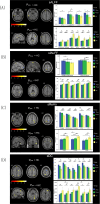Alterations of static and dynamic changes in intrinsic brain activity and its relation to behavioral outcomes in subcortical ischemic stroke after one-month intervention
- PMID: 40200032
- PMCID: PMC11978800
- DOI: 10.1038/s41598-025-96163-8
Alterations of static and dynamic changes in intrinsic brain activity and its relation to behavioral outcomes in subcortical ischemic stroke after one-month intervention
Abstract
Ischemic stroke is a prominent contributor to cognitive dysfunction and disability. Gaining a comprehensive understanding of the neuronal activity and longitudinal changes underlying stroke is crucial for designing effective rehabilitative strategies. However, the neural mechanisms responsible for the longitudinal reorganization of neuronal activity following stroke remain unclear. The objective of this study was to comprehensively investigate potential abnormalities in brain activity among stroke patients before and after one month of intervention (antiplatelet therapy, as well as intravenous citicoline). To achieve this goal, we combined static and dynamic functional imaging indicators for the comprehensive analysis. Twenty ischemic stroke patients at the subacute stage and seventeen age-matched healthy controls were included in the final analysis of this study from one center. Additionally, resting-state functional magnetic imaging scans were conducted on all patients twice with a one-month interval between scans. Four static intrinsic brain activity indicators (static amplitude of low-frequency fluctuation (sALFF), static fractional amplitude of low-frequency fluctuation (sfALFF), static regional homogeneity (sReHo), and static degree centrality (sDC)), along with their corresponding dynamic indicators, were calculated to detect longitudinal alterations in brain activity following stroke onset. Correlation analyses were also performed between these indicators within areas exhibiting group differences as well as clinical scale scores and disease duration. Significant variations in these static and dynamic image indicators were observed among patients with ischemic stroke. There was substantial overlap among the abnormal brain regions detected, primarily including decreased sALFF/sfALFF/dALFF in the bilateral central precuneus, increased sfALFF/sReHo/sDC/dReHo in the left superior precuneus, increased sALFF/sReHo/dfALFF in the left inferior temporal gyrus, decreased sReHo/sDC in the anterior cingulate cortex, increased sReHo/dfALFF in the right inferior parietal lobe, increased sfALFF/sDC in the right fusiform gyrus, as well as decreased sALFF/dALFF and increased sReHo/sDC in the right angular gyrus. Furthermore, these disrupted image indicators in some regions exhibited only partial recovery at the second time point. The percentage changes of these image indicators (sfALFF in the bilateral central precuneus, sDC in the left fusiform and dALFF in the right central precuneus) between the two time points were positively correlated with the percentage changes of clinical scores (FMA and MBI). In combination, this study demonstrates that a comprehensive understanding of abnormal activity and its longitudinal changes in ischemic stroke can be achieved by integrating static and dynamic imaging methods. Regions showing significant overlap among different brain activity indicators and exhibiting consistent image-behavior relationships may have some potential values for predicting clinical outcomes.
Keywords: Brain activity; Dynamic analysis; Longitudinal changes; Resting-state fMRI; Static analysis; Subcortical ischemic stroke.
© 2025. The Author(s).
Conflict of interest statement
Declarations. Competing interests: The authors declare no competing interests. Conflict of interest: The authors declare that there is no conflict of interest. Ethical approval: The current study was approved by the Research Ethics Committee of the Chengdu University of Traditional Chinese Medicine. Consent to participate: All participants provided written informed consent before undergoing MR imaging. Consent to publish: Not applicable.
Figures




Similar articles
-
Static and temporal dynamic changes in brain activity in patients with post-stroke balance dysfunction: a pilot resting state fMRI.Front Neurosci. 2025 Mar 20;19:1558069. doi: 10.3389/fnins.2025.1558069. eCollection 2025. Front Neurosci. 2025. PMID: 40182145 Free PMC article.
-
Alterations of dynamic and static brain functional activities and integration in stroke patients.Front Neurosci. 2023 Oct 27;17:1228645. doi: 10.3389/fnins.2023.1228645. eCollection 2023. Front Neurosci. 2023. PMID: 37965216 Free PMC article.
-
Regional brain function study in patients with primary Sjögren's syndrome.Arthritis Res Ther. 2025 Apr 23;27(1):93. doi: 10.1186/s13075-025-03554-3. Arthritis Res Ther. 2025. PMID: 40270048 Free PMC article.
-
Electroconvulsive therapy changes temporal dynamics of intrinsic brain activity in depressed patients.Psychiatry Res. 2022 Oct;316:114732. doi: 10.1016/j.psychres.2022.114732. Epub 2022 Jul 21. Psychiatry Res. 2022. PMID: 35926361 Review.
-
A systematic review of alterations in brain activation and intensity following stroke: implications for integration and functional outcomes.Front Neurol. 2025 May 26;16:1544008. doi: 10.3389/fneur.2025.1544008. eCollection 2025. Front Neurol. 2025. PMID: 40492169 Free PMC article.
References
-
- Pu, L. et al. Projected global trends in ischemic stroke incidence, deaths and Disability-Adjusted life years from 2020 to 2030. Stroke54, 1330–1339. 10.1161/STROKEAHA.122.040073 (2023). - PubMed
-
- Latifi, S. & Carmichael, S. T. The emergence of multiscale connectomics-based approaches in stroke recovery. Trends Neurosci.47, 303–318. 10.1016/j.tins.2024.01.003 (2024). - PubMed
MeSH terms
Substances
Grants and funding
LinkOut - more resources
Full Text Sources
Medical

